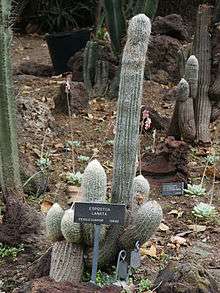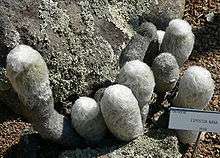Espostoa
| Espostoa | |
|---|---|
 | |
| Espostoa lanata | |
| Scientific classification | |
| Kingdom: | Plantae |
| (unranked): | Angiosperms |
| (unranked): | Eudicots |
| (unranked): | Core eudicots |
| Order: | Caryophyllales |
| Family: | Cactaceae |
| Subfamily: | Cactoideae |
| Tribe: | Trichocereeae |
| Genus: | Espostoa |
| Species | |
|
See text. | |
Espostoa is a genus of columnar cacti, comprising 16 species known from the Andes of southern Ecuador and Peru. It usually lives at an altitude of between 800m and 2500m. Its fruit is edible, sweet, and juicy. The genus is named after Nicolas E. Esposto, a renowned botanist from Lima.

These candle-like cacti are covered with thorns and white hair. Only the older specimens can divide.
In adulthood, a cephalium sometimes appears, similar to the Mexican genus Cephalocereus.
They were discovered by Alexander von Humboldt and Aimé Bonpland in the early nineteenth century.
They are appreciated for their decorative qualities due to their white fleece. They can be propagated by seed. For full development they must be planted in the ground. The cultivated specimens very rarely flourish.
Like all cacti, Espostoa requires a sunny location and well-drained soil. But in summer, it appreciates fertilizer and wetter conditions. In winter, it needs a rest, but the temperature must not drop below 12 °C.
Taxonomy
Species list
Sometimes called "old Peruvian man", it is the most common species. Arborescent type tree up to 5 m high in the wild and 1 m in culture. Trunk diameter 5 to 12 cm in diameter, with 20 to 25 ribs flattened obscured by tissue woolly. The white cover is due to long fuses back. The central sharp goads sometimes cross the wool up to 2 inches long. Older plants have a cephalium on the side from which appear white flowers at night.
- Espostoa baumannii
- Espostoa blossfeldiorum
- Espostoa calva
- Espostoa frutescens
- Espostoa guentheri
- Espostoa huanucoensis
- Espostoa hylaea
- Espostoa lanianuligera
- Espostoa melanostele
- Espostoa mirabilis
- Espostoa nana F.Ritter
- Espostoa ritteri
- Espostoa ruficeps
- Espostoa senilis
- Espostoa superba
Synonymy
The following genera or species have been included in this genus:
Bibliography
- Innes C, Wall B (1995). Cacti' Succulents and Bromaliads. Cassell & The Royal Horticultural Society.
- Edward F. Anderson : "The Cactus Family" (2001)
External links
![]()
- (in English) photos onr www.cactiguide.com
- (in English) Espostoa guentheri
| Wikimedia Commons has media related to Espostoa. |